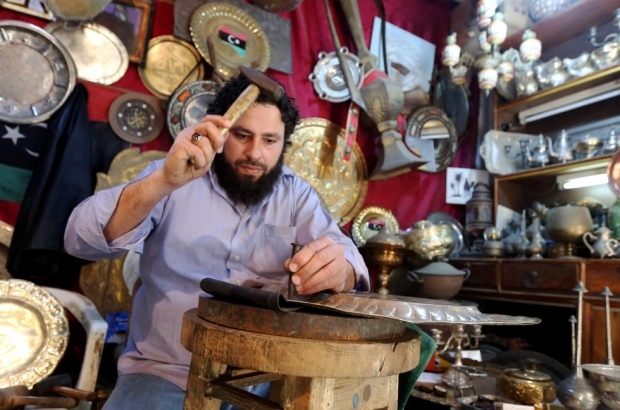Libyan craftspeople struggle to keep Tripoli's Old City alive

Sitting in his workshop among the winding streets of Tripoli's Old City, Abdulwahab al-Saudi bangs away at a piece of copper.
After nearly two hours, he sets the crescent-shaped work down and moves on to the next piece.
With Libya plagued by chaos and violence since the end of the 2011 revolt that toppled Muammar Gaddafi, Saudi has little hope of finding buyers for his copperwork.
But like other craftsmen and merchants in the Old City, he is keeping up traditions that have endured here for centuries.
"No one is buying anymore, we just make the objects and store them," Saudi says.
For more than 2,500 years, Tripoli's Old City has been the beating heart of this city - a vibrant warren of white-washed buildings, workshops and market stalls.
Founded by Phoenician traders in the seventh century BC, it contains a wealth of historic treasures, from the 10th century al-Naqah mosque - one of the oldest in North Africa - to the Christ the King church, which dates back to 1829.
For centuries it has welcomed visitors to Libya's shores. Facing the Mediterranean at its entrance lies the Roman arch of Marcus Aurelius, and next to it the house of the first diplomatic mission to Libya, established in 1630 by the French. Overhead is an Ottoman clock tower built in 1870.
But with Libya a battleground between rival governments and Tripoli under the control of the Islamist-backed Fajr Libya militia, today visitors are scarce.
Next to Saudi's shop sits fellow copper-worker Mukhtar Ramadan, whose family has been in the business for 150 years.
"We have many problems; we are struggling to get in raw materials to do our work," Ramadan says, adding that his sales have fallen to almost nothing since the revolution.
"There isn't any tourism anymore."
'Heartbeat of Tripoli'
Hosam Bash Imam, an advisor for Tripoli's heritage body, said the Old City holds a special place for Libyans.
"The Old City is the heartbeat of Tripoli," he said. "(It) has been through some difficult times and has had to endure fighting and decay, but it still stands."
The Old City was not a major battleground during the revolution, nor in the recent violence that has swept Libya.
But work to maintain it has all but halted since 2011, Imam said, and several years of neglect are starting to show.
Along its narrow cobbled streets, the Old City's paint is peeling and its masonry is crumbling. Many historic sites have been vandalised, including some mosques and gravesites.
In the Old City's former Jewish neighbourhood, a synagogue last used in 1967 - when anti-Jewish riots following the Six Day War led to an exodus of the country's small Jewish community to Italy, Israel and the US - is boarded up and empty, a Star of David and Hebrew inscriptions etched above the entrance.
As he weaves colourful yarns into dresses at the silk market, Jamal Mustafa Mahmoud says he has faith that the Old City - and its traditional craftsmen - will survive.
"We are spiritually connected to this trade. My father lived with it, my grandfather was here and my children will be," said Mahmoud, 60.
"The Old City is like the oxygen you breathe, it is history. Many people have passed through here and the city will face a lot of adversity, and it will pull through."
New MEE newsletter: Jerusalem Dispatch
Sign up to get the latest insights and analysis on Israel-Palestine, alongside Turkey Unpacked and other MEE newsletters
Middle East Eye delivers independent and unrivalled coverage and analysis of the Middle East, North Africa and beyond. To learn more about republishing this content and the associated fees, please fill out this form. More about MEE can be found here.




